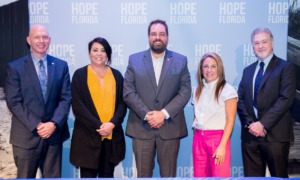If you’re searching for a place to get training for a job in America’s burgeoning “green economy,” then consider a community college as your dream school.
That’s the conclusion of a report titled “Going Green: The Vital Role of Community Colleges in Building a Sustainable Future and Green Workforce” that was released today. today
The report – prepared jointly by the National Council for Workforce Education and the Academy of Educational Development – describes community colleges as the “perfect gateway to good green jobs.” That’s largely because most of the jobs in the emerging “green workforce” will require more than a high school diploma but less than a four-year college degree, according to the report.
The report predicts green jobs represent perhaps the “greatest workforce development opportunity on the horizon for community colleges.”
Community college representatives says policymakers need to keep the report’s findings in mind when funding decisions are made and as the economy pushes people back to school to acquire more skills.
“There will be a huge emphasis on the green economy coming up in the next few years,” said Jennifer Hayward, sustainability coordinator at Lane Community College in Eugene, Ore., one of several community colleges mentioned in the report.
She lamented that community colleges in Oregon recently suffered budget cuts, but universities and K-12 schools did not. She said enrollment in the college’s green job programs has shot up 50 percent in recent years, while overall enrollment at Lane has only increased by five percent.
“I think that people realize that green jobs are a great way to go, that there will be jobs in those areas and that’s what they want to do,” Hayward said.
Much of the report is dedicated to examples of some of the most innovative things that community colleges are doing now to prepare students for jobs in the green economy. Although heavy on the green jargon of today, the report serves as a catalog of contemporary community college programs that are training students to build and design things in a way that won’t make the world as hot and dirty as scientists and others say it has been made by past pollutive industrial practices.
For instance, at Red Rocks Community College in Lakewood, Colo., students can take courses in solar panel installation or energy system design. At Lane Community College, student volunteers helped retrofit faucet aerators in order to reduce water flow.
At Central Carolina Community College in Pittsboro, N. C., a plant is being built to produce biodiesel and ethanol from various raw materials. At the Workforce Development Institute at Hudson Valley Community College in Troy, N.Y., students can get training from the school’s new Center for Energy Efficiency & Building Science in how to incorporate energy-saving methods into the building trades.
Many of the jobs of this new green workforce already exist, but the positions are being transformed, and those who work them must be reoriented. For that reason, the report states, it’s important that community colleges modify their course offerings accordingly.
“From a community college perspective, this means that while some emerging green occupations will require the creation of new industry-recognized credentials and training programs, many will only require modifications to existing programs and courses to integrate green skills,” the report states. “Similarly, as new career pathways are developed specific to renewable energy, the majority of job trajectories in green industries will be built into traditional career pathways.”
Community colleges will have to make a special effort to understand just what kinds of jobs will be in demand in the future, the report states. At the same time, much of the information on “high-growth, high-demand” occupations for the new energy economy is “not easily obtained.” For this the report blames various policy and investment forces that are “still very much in flux.”
“As a result,” the report states, “community colleges may find it beneficial to collaborate with workforce and economic development entities that may be able to customize local labor market information, survey regional employers or develop industry-specific economic impact models that highlight major investments in these industries in the region.”
The report concludes with several other “action steps” for community college leaders to create a “sustainable future” and green workforce. The report suggests the community colleges:
* Serve as a community or regional catalyst for educating diverse audiences about environmental stewardship, sustainable development and the green workforce.
* Reduce the actual pollution and waste being emitted at the community colleges themselves.
* Make sustainability a prominent part of the campus culture, from how the institution is run to the courses offered to students.
* Join forces with “leading green community colleges” or existing collaboratives to avoid doing what’s already been done.
* Promote the college’s sustainability initiatives and green workforce development programs to help generate enthusiasm and support from students, faculty, staff, alumni, policymakers, the community and potential funders.
To read the report, go to http://www.aed.org/News/Releases/going_green.cfm






























